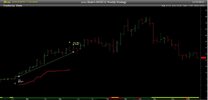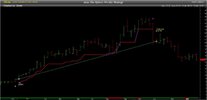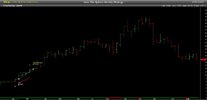- Joined
- 28 December 2013
- Posts
- 6,401
- Reactions
- 24,350
What’s right is whatever works for you
Cutting losses has to be part of a solid trading plan, which includes applying a few different stop methodologies. I've never found "joy" in applying a "Take profit Stop" or by taking an early exit on profit targets, these limit your gains on a trade.
Picking one example (JIN)
Traders have a habit of picking one trade or individual trades rather than accepting that an "individual trade" is only one part of a system. It's important to find a suitable exit methodology for a system rather than individual positions. Applying an exit strategy because one or two positions "didn't play nice" is no reason to select one method over the other to drive the outcome.
When developing a strategy
Just having "sound risk management", & "position sizing" will be for naught if you don’t have the discipline to consistently execute your trading rules. Also, if you’re going to take one trade, take them all, a reference @ducati916 made recently. (In reference to trading your edge)
Summary
With "Trend Trading", you need to be able to accept trades that do not work. Find a strategy that’s right for you - then do your very best to stay disciplined, for better & for worse. Stay focused as trading is so uncertain. It’s a combination of doing the little things right that makes the difference between being consistently profitable or constantly losing over time.
Skate
Cutting losses has to be part of a solid trading plan, which includes applying a few different stop methodologies. I've never found "joy" in applying a "Take profit Stop" or by taking an early exit on profit targets, these limit your gains on a trade.
Picking one example (JIN)
Traders have a habit of picking one trade or individual trades rather than accepting that an "individual trade" is only one part of a system. It's important to find a suitable exit methodology for a system rather than individual positions. Applying an exit strategy because one or two positions "didn't play nice" is no reason to select one method over the other to drive the outcome.
When developing a strategy
Just having "sound risk management", & "position sizing" will be for naught if you don’t have the discipline to consistently execute your trading rules. Also, if you’re going to take one trade, take them all, a reference @ducati916 made recently. (In reference to trading your edge)
Summary
With "Trend Trading", you need to be able to accept trades that do not work. Find a strategy that’s right for you - then do your very best to stay disciplined, for better & for worse. Stay focused as trading is so uncertain. It’s a combination of doing the little things right that makes the difference between being consistently profitable or constantly losing over time.
Skate





